Legal notice
Please note that the usage of the exercises presented in this book will be at your own risk. Meyer Meyer Sports GmbH and the authors will not be liable in any way (including for negligence) for any injury, loss, damage, costs or expenses suffered by using the exercises in this book. For further legal information regarding the use of the exercises given in this book, please refer to the respective law of your country.
2 Attack points on the neck
2.1 Carotis/Common carotid artery
The carotid artery is on the left and right hand side of the windpipe and the esophagus and is covered only by the neck side muscle and skin. In the region of the neck, one can measure the pulse easily. In the region of the larynx, it divides into the arteria carotis interna and arteria carotis externa.
One of the most important points of measuring blood pressure (glomus caroticum) is at this fork in the arteries. This fork is necessary so that when there is a sudden increase of blood pressure the vessels do not break and lead to bleeding. When the blood pressure increases, the internal wall of the carotid sinus stretches, which is registered by the glomus caroticum and transmitted to the brain by the nervous system. Attack: Strike with either the inside or outside of the hand (also in strangling attacks). 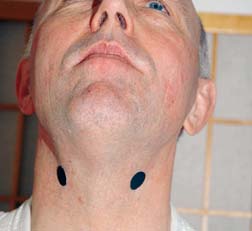
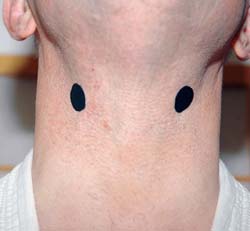
Target mark. Effects: The heightened blood pressure stimulates the brain causing the blood vessels to enlarge immediately, specially in the veins of the stomach region - unconsciousness is possible due to the lack of blood supply to the brain.
If lying horizontally, the blood flows back into the brain and one will awaken. In addition, the heart can slow down and be weakened. There is also a lower rate of breathing, which can eventually even come to a full stop. There is a danger of heart attack. Further injuries can result from any fall. There is also the danger that plaques can loosen on the internal sides of the carotid artery, move along through the system and cause a stroke in the brain.
Such plaques as these are especially found in the fork of the common carotid artery. The danger is higher with increasing age. As already pointed out in the Introduction, regarding the impact on Like, one can be irresponsible and be equally juristically dubious when you see this point in the various training videos misused as "evidence" that Kyusho is effective. It can be a particularly delicate subject if there are injuries where the effects are more serious than those planned. Comments on use: Suitable for use as Atemi, as well as strangling techniques. 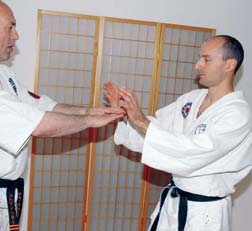
The opponent tries to grab hold. 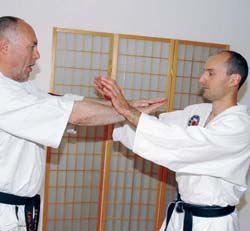
The defender moves forward holding his arms in a wedge V shape. 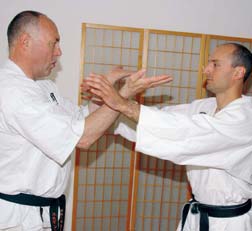
The attack is deflected to the outside. 
The attacker slides past the outside of the defender. 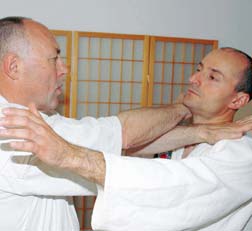 Pincer attack using the edge of the hands at the carotid arteries.
Pincer attack using the edge of the hands at the carotid arteries.
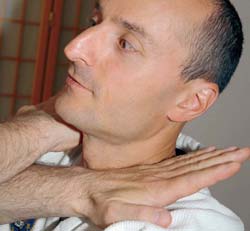
Close-up. 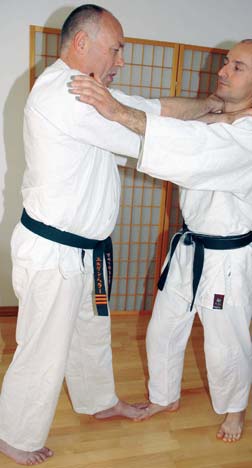 In order to bolster the technique, the attacker's foot is pinned down by standing on it.
In order to bolster the technique, the attacker's foot is pinned down by standing on it.
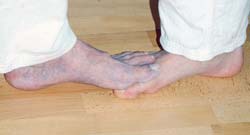
Close-up.
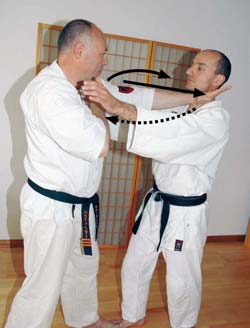
Continue the attack by rattling the sides of the hands against the target.
Additional sequences:
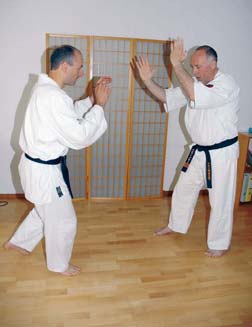
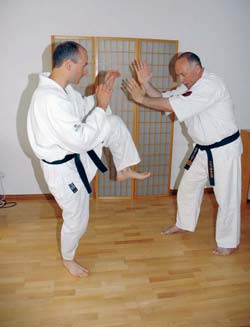
Attack using a straight kick with the foot.
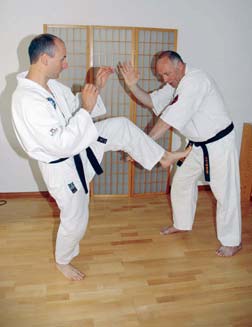
The kick is swept away by the left arm.
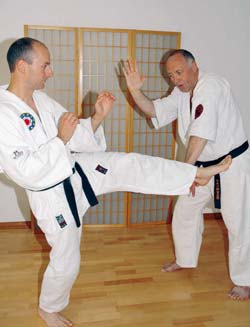
The defensive action causes the attacker's kick to be extended.

The circular sweeping motion in the counterattack is moved to the use of the inner edge of the hand.
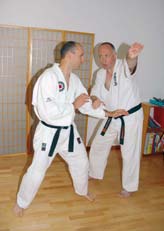
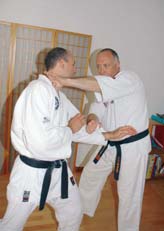
Counterattack with the inside edge of the hand and control of the elbow joint at the same time.
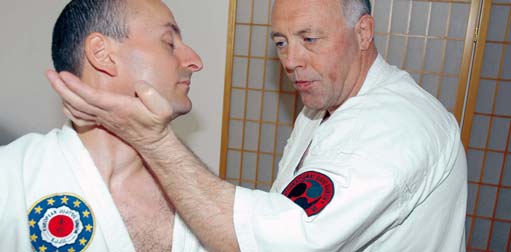
The strike can also be executed using the outside edge of the hand (Shuto).
2.2 Nape of the neck/Cervical spine
Consists of the seven vertebrae (C1-C7) between the head and the thoracic spine and is supported by the neck and back muscles as well as several other vertebrae.
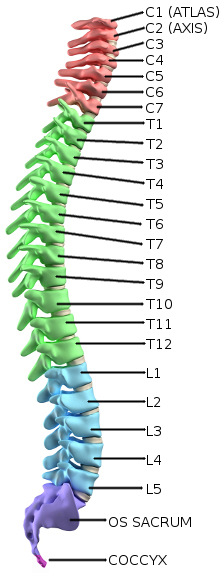 Attack:
Attack: Neck lever, punch.
 Attack:
Attack: Neck lever, punch.
In a rotating neck lever, it is crucial that a combination of stretching the neck and the rotation of the head is applied in order to achieve the optimum effect. 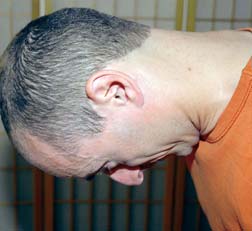 Demonstrating the stretching of the neck.
Demonstrating the stretching of the neck. 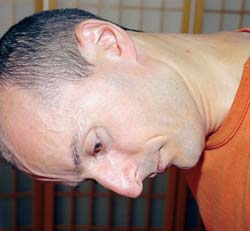



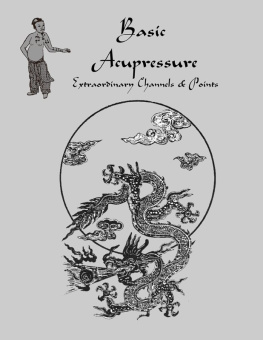
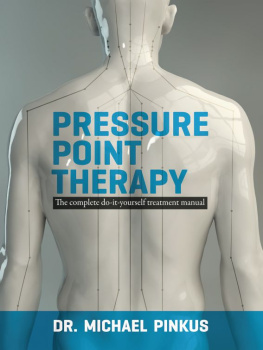
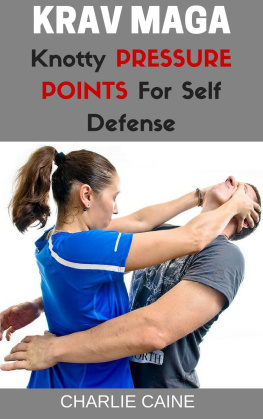
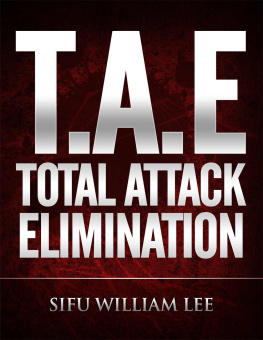
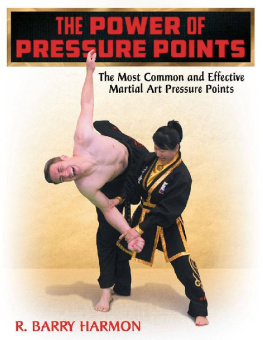








 Pincer attack using the edge of the hands at the carotid arteries.
Pincer attack using the edge of the hands at the carotid arteries.
 In order to bolster the technique, the attacker's foot is pinned down by standing on it.
In order to bolster the technique, the attacker's foot is pinned down by standing on it.










 Demonstrating the stretching of the neck.
Demonstrating the stretching of the neck. 